Alternative Treatments
Experience Fast and Effective Hip Pain Relief
Are you always restricted by hip pain? If so, you are not alone. Many people suffer from hip soreness, which makes daily life difficult and limited. However, there is hope. In this article, we will look at the best ways to relieve hip discomfort and regain your range of motion.
Understanding Hip Pain
Hip discomfort can be painful, limiting your ability to do even the most basic duties. Understanding the underlying cause of your pain is the first step toward effective therapy. Injuries, arthritis, and other underlying disorders are all potential causes of hip discomfort.
Acute hip pain can be caused by fractures, sprains, strains, or dislocations. These injuries frequently necessitate prompt medical attention, which may include surgical surgery. Chronic disorders, such as osteoarthritis, rheumatoid arthritis, bursitis, and tendinitis, can cause long-term hip pain. Identifying the particular reason of your hip discomfort will assist you in determining the best course of treatment.

Common Causes of Hip Pain
Hip pain can have several reasons, each needing a unique approach to pain management. The following are some prevalent reasons of hip pain:
- Osteoarthritis: Osteoarthritis is a degenerative joint disease in which the protecting cartilage in the hip joint breaks down over time, resulting in pain, stiffness, and limited mobility.
- Rheumatoid Arthritis: Rheumatoid Arthritis is an inflammatory illness that causes inflammation in joints, especially the hip, resulting in discomfort, edema, and joint destruction.
- Bursitis: Bursitis is an inflammation of the bursae, which are tiny fluid-filled sacs that cushion the hip joint, causing discomfort and soreness.
- Tendinitis: Tendinitis is an inflammation of the tendons that surround the hip joint, which is commonly caused by overuse or repetitive strain, resulting in pain and decreased range of motion.
- Hip Fracture: A break in the hip bone caused by a fall or accident, which causes considerable pain, edema, and trouble walking.
When to Seek Medical Attention for Hip Pain
While some cases of hip pain can be managed at home, certain situations require immediate medical attention. If you experience any of the following symptoms, it is important to seek medical help:
- Intense pain that does not improve with rest, ice, or over-the-counter pain medications.
- Inability to bear weight on the affected hip or leg.
- Severe swelling or deformity in the hip area.
- Fever, chills, or other signs of infection.
- Sudden onset of hip pain after a fall or accident.
Remember, early diagnosis and treatment can significantly improve your chances of a full recovery.

Non-Surgical Relief Options for Hip Pain
If your hip pain is not severe and does not require surgical intervention, there are several non-surgical treatment options you can explore. These methods aim to reduce pain and improve mobility without the need for invasive procedures. Here are some non-surgical relief options for hip pain:
- Physical Therapy: A competent physical therapist can create a specific exercise program to strengthen the muscles surrounding the hip joint, increase flexibility, and alleviate discomfort.
- Weight Management: Carrying excess weight puts additional strain on the hip joint, aggravating pain and discomfort. Maintaining a healthy weight through adequate nutrition and exercise might help reduce hip pain.
- Assistive Devices: Using crutches, canes, or walkers can help relieve strain on the hip joint and give support while walking or doing other activities.
- Heat and Cold Therapy: Using hot or cold packs on the affected area might help relieve pain and inflammation. Heat therapy increases blood flow and relaxation, whilst cold therapy numbs the area and decreases swelling.
- Transcutaneous Electrical Nerve Stimulation (TENS): TENS therapy uses low-voltage electrical currents to stimulate nerves and alleviate pain. This non-invasive treatment may be beneficial for controlling hip pain.
Remember to consult with a healthcare professional before starting any new treatment regimen to ensure it is safe and suitable for your specific condition.
Physical Therapy Exercises for Hip Pain Relief
Physical therapy exercises play a crucial role in relieving hip pain and improving mobility. These exercises are designed to strengthen the muscles around the hip joint, increase flexibility, and promote proper alignment. Here are some effective physical therapy exercises for hip pain relief:
- Hip Flexor Stretch: Begin by kneeling with one leg on the ground and the other foot flat on the floor in front of you. Slowly lean forward while keeping your back straight until you feel a stretch at the front of your hip. Hold for 30 seconds, then repeat on the opposite side.
- Glute Bridge: Lie on your back, knees bent, feet flat on the floor. Slowly raise your hips off the ground, activating your glutes and core muscles. Hold for a few seconds before lowering back down. Repeat for 10 to 15 times.
- Clamshell Exercise: Lie on your side, knees bent, feet together. Lift your upper knee as high as possible while keeping your feet together and not moving your pelvis. Hold for a few seconds before lowering back down. Repeat 10–15 times on each side.
- Standing Hip Abduction: To maintain balance, stand next to a firm support, such as a chair or a wall. Lift one leg out to the side and maintain it straight. Hold for a few seconds before lowering back down. Repeat 10–15 times on each side.
- Piriformis Stretch: Sit on the edge of a chair, one ankle resting on the opposing knee. Gently press down on the lifted knee to feel a stretch in your buttocks. Hold for 30 seconds, then repeat on the opposite side.
These exercises should be performed under the guidance of a qualified physical therapist to ensure proper form and prevent further injury. Gradually increase the intensity and duration of the exercises as your strength and flexibility improve.

Over-the-Counter Pain Medications for Hip Pain
Over-the-counter pain medications can provide temporary relief from hip pain. These medications are readily available without a prescription and can help reduce inflammation and alleviate discomfort. Here are some common over-the-counter pain medications used for hip pain:
- Nonsteroidal anti-inflammatory drugs (NSAIDs): Ibuprofen, naproxen, and aspirin can all help with hip discomfort, inflammation, and edema. Follow the suggested dosage guidelines and speak with a doctor if you have any underlying medical conditions or are taking any other medications.
- Acetaminophen: Acetaminophen is an analgesic that can alleviate pain but has no anti-inflammatory qualities. It is typically safe for most people when used as prescribed. However, excessive or continuous use might harm the liver, so stick to the suggested dosage and avoid exceeding the daily limit.
- Topical Analgesics: Topical analgesics are creams, gels, or patches that include chemicals like menthol or capsaicin and can be applied directly to the painful location to provide localized pain relief. These topical analgesics operate by numbing the region or interrupting pain signals.
It is important to note that over-the-counter pain medications provide temporary relief and should not be used as a long-term solution. If your hip pain persists or worsens, it is advisable to consult with a healthcare professional for further evaluation and treatment.
Natural Remedies for Hip Pain Relief
If you prefer natural alternatives or want to complement traditional treatments, there are several natural remedies that may provide relief from hip pain. These remedies focus on reducing inflammation, promoting healing, and improving overall well-being. Here are some natural remedies to consider:
- Heat and Cold Therapy: Placing a heating pad or warm compress on the affected area will help relax muscles, promote blood circulation, and alleviate discomfort. In contrast, cold therapy, such as ice packs or cold compresses, can assist reduce inflammation and numb the affected area.
- Essential oils: Some essential oils contain anti-inflammatory and analgesic effects that can help alleviate hip discomfort. Oils like lavender, peppermint, eucalyptus, and chamomile can be diluted with a carrier oil and used directly to the problematic area or mixed into a warm bath to relieve discomfort.
- Acupuncture: This ancient Chinese treatment involves inserting small needles into certain places on the body to increase energy flow and improve healing. Acupuncture has been shown to be beneficial in relieving pain and increasing joint function in people with hip pain.
- Herbal Supplements: Anti-inflammatory herbs including turmeric, ginger, and devil’s claw may aid with hip discomfort. However, before starting any herbal supplements, talk with a healthcare practitioner because they may interfere with prescriptions or cause unwanted effects.
- Mind-Body Techniques: Exercises like yoga, tai chi, and meditation can help reduce stress, increase flexibility, and enhance overall well-being. These mind-body approaches can be used in conjunction with other treatments to provide holistic relief for hip pain.
Natural therapies can be an effective supplement to your pain management practice, but keep in mind that individual results may vary. It is best to contact with a healthcare practitioner before starting any new natural remedies, especially if you have underlying medical concerns or are using other medications.

Surgical Options for Hip Pain
In some cases, surgical intervention may be necessary to alleviate hip pain and improve joint function. Surgery is typically considered when conservative treatments have failed to provide relief or when there is significant joint damage. Here are some surgical options for hip pain:
- Total Hip Replacement: In this surgery, the damaged portions of the hip joint are removed and replaced with artificial components composed of metal, plastic, or ceramic. Total hip replacement can considerably relieve pain and improve mobility in people suffering from severe hip arthritis or joint deterioration.
- Hip Resurfacing: In this operation, the damaged surface of the hip joint is trimmed and covered with a metal prosthesis to preserve more of the native bone. Hip resurfacing is appropriate for younger, active people with healthy bones and minimal joint deterioration.
- Hip Arthroscopy: Hip Arthroscopy is a minimally invasive treatment that includes inserting a small camera and specialized tools into the hip joint to diagnose and treat a variety of hip problems. Hip arthroscopy is used to repair damaged cartilage, remove loose bodies, and treat specific hip impingements.
- Hip Osteotomy: This operation reshapes the hip joint to enhance alignment and relieve stress on the affected area. Hip osteotomy is usually advised for people with certain hip abnormalities or early-stage arthritis.
The decision to undergo surgery should be made in consultation with a qualified orthopedic surgeon. They will assess your individual case, consider your overall health, and discuss the risks and benefits of each surgical option.
Lifestyle Changes to Prevent Hip Pain
Prevention is always better than cure. Making certain lifestyle changes can help prevent or reduce the risk of developing hip pain. Here are some lifestyle modifications you can consider:
- Maintain a Healthy Weight: Excess weight puts additional strain on the hip joint, leading to increased wear and tear. By maintaining a healthy weight through regular exercise and a balanced diet, you can reduce the risk of hip pain and other joint-related issues.
- Practice Good Posture: Poor posture can contribute to hip pain by placing unnecessary stress on the joint. Maintain proper alignment while sitting, standing, and walking to prevent hip pain and promote overall musculoskeletal health.
- Exercise Regularly: Engaging in regular physical activity can help strengthen the muscles around the hip joint, improve flexibility, and reduce the risk of hip pain. Incorporate exercises that target the hips, such as walking, swimming, cycling, or low-impact aerobics, into your routine.
- Use Proper Body Mechanics: When lifting heavy objects or performing repetitive tasks, use proper body mechanics to minimize stress on the hip joint. Bend from the knees, keep your back straight, and avoid twisting or jerking motions.
- Take Breaks: If your job requires prolonged sitting or standing, take regular breaks to stretch and move around. This can help prevent stiffness and reduce the risk of hip pain caused by prolonged immobility.
By implementing these lifestyle changes, you can take proactive steps towards maintaining hip health and preventing future pain and discomfort.
Conclusion
Hip discomfort can have a substantial influence on your quality of life, but with the appropriate treatment, you can get relief. Understanding the root cause of your hip discomfort is critical in determining the best therapy options. Whether you choose non-surgical techniques like physical therapy, over-the-counter pain medications, or natural therapies, or if surgery is required, there are alternatives to help relieve your pain and increase your mobility.
Remember to speak with a healthcare expert to get an accurate diagnosis and specific treatment plan. By taking a proactive approach to managing your hip pain and implementing required lifestyle modifications, you may reclaim control of your life and move forward painlessly. Don’t let hip pain hold you back anymore. Explore the many relief choices to see what works best for you.
Trusted Health, Wellness, and Medical advice for your well-being


